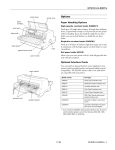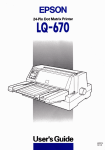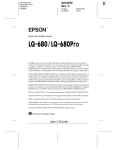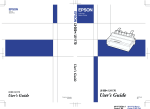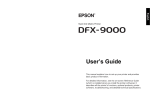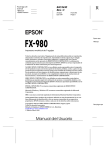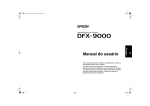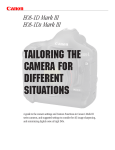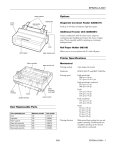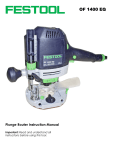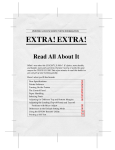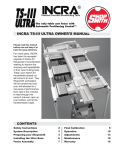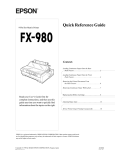Download Epson LQ-670 Product Information Guide
Transcript
EPSON LQ-670 Line spacing: paper thickness lever printer cover 1/6-inch or programmable in 1/360-inch increments Paper feed speed: ribbon cartridge Normal Mode print head Continuous Intermittent control panel 5 inches/second 60 ms/line at 1/6-inch line spacing Copy Mode Continuous Intermittent left edge guide Printable columns: knob paper guide right edge guide 3.6 inches/second 70 ms/line at 1/6-inch line spacing paper release lever paper support Characters per inch Maximum printed characters per column 10 cpi 106 12 cpi 127 15 cpi 159 17 cpi 181 20 cpi 212 Buffer: 64KB or 0KB (selectable in the default-setting mode or the EPSON Remote! utility) Bitmap fonts: sprocket units parallel interface Printer Specifications Font Characters per inch available EPSON Draft 10, 12, 15 EPSON Roman 10, 12, 15, proportional EPSON Sans Serif 10, 12, 15, proportional EPSON Courier 10, 12, 15 EPSON Prestige 10, 12 EPSON Script 10 Printing EPSON Script C proportional Printing method: EPSON Orator 10 24-pin impact dot matrix EPSON Orator S 10 EPSON OCR-B 10 Printing speed: Scalable fonts: Characters per inch Quality Characters/second/line 10 cpi High speed draft 300 Font Available sizes 10.5, 8 to 32 points, in 2-point increments 10 cpi Normal draft 250 EPSON Roman 10 cpi Letter quality 83 EPSON Sans Serif 10.5, 8 to 32 points, in 2-point increments 12 cpi Draft 300 EPSON Roman T 10.5, 8 to 32 points, in 2-point increments 12 cpi Letter quality 100 ESPON Sans Serif H 10.5, 8 to 32 points, in 2-point increments * The paper thickness lever position or an overheated print head may affect the printing speed. Barcode fonts: EAN-13, EAN-8, Interleaved 2 of 5, UPC-A, UPC-E, Code 39, Code 128, POSTNET Printing direction: Bidirectional logic seeking for text and graphics printing. Unidirectional text or graphics printing can be selected using software commands. Character tables: One italic and 10 graphics character tables. 3/97 EPSON LQ-0670 - 1 EPSON LQ-670 Part of multipart form Character sets: 14 international character sets and one legal character set Quality Emulation: 12 to 15 lb (40 to 58 g/m2) Plain paper, recycled paper, and carbonless multi-part forms with spot gluing or paper stapling on both sides ESC/P2 IBM 2390 Plus Labels: Paper Note: Use only labels mounted on continuous backing sheets. Note: Use recycled paper, labels, envelopes, and postcards only under normal temperature and humidity conditions, as follows: Size Temperature Humidity 59° to 77°F (15° to 25°C) 30% to 60% RH Width Height Backing sheet Width Length/page Paper storage conditions: Temperature 64° to 72°F (18° to 22°C) Humidity 40% to 60% RH 3.6 to 11.7 inches (91 to 297 mm) Length 3.6 to 16.5 inches (90 to 420 mm) Thickness 0.0025 to 0.0055 inches (0.065 to 0.14 mm ) Weight 14 to 24 lb (52.3 to 90 g/m2) Quality Plain paper, bond paper, and recycled paper Weight 3.6 to 11.7 inches (91 to 297 mm) Length 3.6 to 16.5 inches (90 to 420 mm) 3.6 to 11.7 inches (90 to 297 mm)* *For the type glued at the side of the form Copies 1 original + 4 copies Total thickness 0.0047 to 0.015 inches (0.12 to 0.39 mm) Weight/part 12 to 15 lb (40 to 58 g/m2 ) Quality Carbonless multi-part forms with a line of glue at the top or the side of the form Size 4.0 to 12.0 inches (101.6 to 304.8 mm) Length/page 4.0 to 22.0 inches (101.6 to 558.8 mm) Copies 1 original plus 4 copies Total thickness 0.0025 to 0.015 inches (0.065 to 0.39 mm) 6.5 × 3.6 inches (165 × 92.1 mm) 9.5 × 4.1 inches (241 × 105 mm) Thickness 0.0063 to 0.0197 inches (0.16 to 0.52 mm) Any differences in thickness within the printable area must be less than 0.0098 inches (0.25 mm). Weight 12 to 24 lb (45 to 91 g/m2) Quality Bond envelopes, plain envelopes, and airmail envelopes without glue on the flap Postcards: Width 4.13 to 5.83 inches (105 to 148 mm) Length 4.1 to 5.83 inches (105 to 148 mm) Thickness 0.0087 inches (0.22 mm) Weight 51 lb (192 g/m2 ) Quality Plain paper and recycled paper Roll paper: Weight Ordinary paper 14 to 22 lb (52 to 82 g/m2) 2 - EPSON LQ-670 No. 6 No. 10 Continuous paper (ordinary and multi-part): Width 17 lb (68 g/m2 ) Envelopes: Single-sheet multi-part forms (manual insertion): Width 4.0 to 12.0 inches (101.6 to 304.8 mm) 4.0 to 22.0 inches (101.6 to 559 mm) Thickness Backing sheet 0.0028 to 0.0035 inches (0.07 to 0.09 mm) Total thickness 0.0063 to 0.0075 inches (0.16 to 0.19 mm) Single sheets (manual insertion): Width 2.5 inches (63.5 mm), minimum 0.94 inches (23.8 mm), minimum 3/97 Width 8.5 inches (216 mm) Thickness 0.0028 to 0.0035 inches (0.07 to 0.09 mm) EPSON LQ-670 Weight 14 to 22 lb (52.8 to 82 g/m2 ) Labels Printable area: Single sheets C B C A B B C C A Printable area A 0.47 inches (12 mm) or more B 0.047 inches (1.2 mm) or more C 0.12 inches (3 mm) or more A Envelopes and postcards A The minimum top and bottom margins are 0 inches (0 mm). B The minimum left and right margins are 0.12 inches (3.0 mm). The maximum printable width is 10.6 inches (297 mm). A Continuous paper Printable area B B Printable area A A A A The minimum top and bottom margins are 0 inches (0 mm). B The minimum left and right margins are 0.12 inches (3.0 mm). Printable area Roll paper B A B B B A The minimum top and bottom margins (above and below the perforation) are 0.17 inches (4.2 mm). B The minimum left and right margins are 0.51 inches (13 mm). The maximum printable width is 10.6 inches (269 mm). Printable area A A The minimum top and bottom margins are 0 inches (0 mm). B The minimum left and right margins are 0.12 inches (3.0 mm). 3/97 EPSON LQ-0670 - 3 EPSON LQ-670 Mechanical Humidity (without condensation): Paper feed methods: Operation: Friction feed from front Built-in push tractor Cut-sheet feeder (optional) Roll paper holder (optional) Storage: Ribbon: Safety standards UL1950 with D3 CSA C22.2 No.950 with D3 EMI FCC part 15 subpart B class B CSA C108.8 class B Safety approvals Black ribbon cartridge (S015016) Ribbon life 10% to 80% RH 30% to 60% RH (for envelopes and labels) 0% to 85% RH 2 million characters (at 10 cpi in letterquality mode with 48 dots/character) Total print amount: Acoustic noise: 6.5 million lines (except print head) Approx. 55 dB (A) (ISO 7779 pattern) Print head life: Parallel Interface Specifications 200 million strokes/wire MTBF: The printer comes with a bidirectional, 8-bit, parallel interface and an optional interface slot. 5000 POH Dimensions and weight (with paper guide): Height: Width: Depth: Weight: Forward channel 10.1 inches (256 mm) 18.5 inches (469 mm) 16.9 inches (429 mm) Approx. 19.8 lb (9.0 kg) Transmission mode: 8-bit parallel, IEEE-1284 compatible mode Adaptable connector: 57-30360 (Amphenol) or equivalent Electrical Rated voltage Input voltage range Rated frequency range Input frequency range Rated current Power consumption AC 120 V AC 103.5 to 132 V 50 to 60 Hz 49.5 to 60.5 Hz 0.7 A (maximum 2.2 A depending on the character type) Approx. 30 W (ISO/IEC 10561 Letter pattern) Synchronization: STROBE pulse Handshaking: BUSY and ACKNLG signals Signal level: TTL compatible (IEEE-1284 level 1 device) Reverse channel Transmission mode: IEEE-1284 Nibble Mode Adaptable connector: 57-30360 (Amphenol) or equivalent Synchronization: Refer to the IEEE-1284 specification Environmental Handshaking: Refer to the IEEE-1284 specification Temperature: Signal level: IEEE-1284 Level 1 device Operation (without condensation): 41° to 95°F (5° to 35°C) 59° to 77°F (15° to 25°C) for multi-part forms, envelopes, postcards, and labels Data transmission timing: Refer to the IEEE-1284 specification Storage: 4 - EPSON LQ-670 Extensibility request: The printer responds to the extensibility request in the affirmative when the request is 00H or 04H, which means: 00H: Request nibble mode of reverse channel transfer 04H: Request device ID in nibble mode of reverse channel transfer -22° to 140°F (-30° to 60°C) 3/97 EPSON LQ-670 Dimensions and weight (including the printer): Optional Cut-Sheet Feeder Specifications With only bin 1 installed Height: Width: Depth: Weight: The specifications below apply to both the high-capacity cutsheet feeder (C806781, bin 1) and the second-bin cut-sheet feeder (C806791, bin 2). 17.6 inches (446 mm) 18.5 inches (469 mm) 26.0 inches (660 mm) 24.3 lb (11.0 kg) With bin 1 and bin 2 installed Note: You can load the same types of single sheets, multi-part forms, envelopes, and postcards in the high-capacity cut-sheet feeder as you load in the printer's paper guide. You can load only single-sheet paper in the second-bin cut-sheet feeder. Height: Width: Depth: Weight: 17.6 inches (446 mm) 18.5 inches (469 mm) 28.9 inches (733 mm) 26.0 lb (11.8 kg) Capacity of bin 1: Single sheets A3 size paper Other paper Single-sheet multi-part Using the Control Panel Up to 110 sheets of 22 lb (82 g/m2) paper Up to 135 sheets of 17 lb (64 g/m2) paper Up to 150 sheets of 22 lb (82 g/m2) paper Up to 185 sheets of 17 lb (64 g/m2 ) paper This section explains how you can use the control panel to control the basic operation of the printer and to perform more advanced operations, such as making changes to default settings or activating the printer’s quiet mode. Up to 40 sheets of 12.5 lb (47 g/m2) paper forms Envelopes Up to 25 plain or bond envelopes Up to 30 airmail envelopes Postcards Up to 50 plain paper cards Basic Control Panel Functions The indicator lights on the control panel let you monitor the current status of the printer, and the buttons let you control many printer operations. Note: The total thickness of the paper stack can be up to 0.59 inches (15 mm). If the weight of your paper differs from the values above, the total thickness of the paper stack should be less than 0.59 inches (15 mm). Capacity of bin 2: Single sheets Up to 50 sheets of 22 lb (82 g/m2) paper Up to 60 sheets of 17 lb (64 g/m2 ) paper Note: The total thickness of the paper stack can be up to 0.20 inches (5 mm). Environmental: Temperature Operation: Storage: Lights 41° to 95°F (5° to 35°C) -22° to 140°F (-30° to 60°C) Paper Out (red) On when the printer runs out of paper. Flashes when the paper is jammed. Humidity (without condensation) Operation: Storage: 10% to 80% RH 0% to 85% RH 3/97 EPSON LQ-0670 - 5 EPSON LQ-670 Pause (orange) Load/Eject On when the printer is not ready to print data, paper is out or jammed, or you press the Pause button to pause printing. Flashes when the printer is in micro-adjust mode or the print head is too hot. Press this button to advance single-sheet or continuous paper to the loading position. (The printer normally loads paper automatically.) If a single sheet is already in the loading position, press this button to eject it. If continuous paper is in the loading or tear-off position, press this button to feed it backward to the standby position.This button also executes micro-adjust mode Font (three lights, green) The printer uses the three Font lights to indicate the selected font as follows: o o o n n n n o n n o o n n n o n o n o n LF/FF (line feed/form feed) Draft Roman Sans Serif Courier Prestige Script Others* Press this button briefly to feed the paper forward one line. Hold it down to eject a single sheet or advance continuous paper to the top of the next page. You can also use this button to load a single sheet of paper from the optional cut-sheet feeder or to feed continuous paper from the standby position to the loading position. This button also executes micro-adjust mode. n = On, o = Off Font * This light pattern means that a font other than those indicated on the control panel has been selected using the default-setting mode or the EPSON Remote! utility. (The fonts available in the default-setting mode or EPSON Remote! are: OCR-B, Orator, Orator-S, Script C, Roman T, or Sans Serif H.) Press this button to select one of the following fonts: Draft, Roman, Sans Serif, Courier, Prestige, Script, or Others. Others means a font other than those indicated on the control panel has been selected using the default-setting mode or the EPSON Remote! utility. Condensed (green) Printing with the Draft font requires fewer dots per character, which significantly increases the printing speed. However, printing with this font also reduces print quality. When you need letter-quality printing, select a font other than Draft. On when you press the Condensed button to print condensed characters. Tear Off/Bin (two lights, green) The printer uses the two Tear Off/Bin lights to indicate the following: f f o n n o n n Note: The typestyle samples on the control panel are meant as guides only; printed results may differ slightly. The perforation of your continuous paper is at the tear-off position. The optional high-capacity cut-sheet feeder (bin 1 of the double-bin feeder) is selected. The optional second-bin cut-sheet feeder (bin 2 of the double-bin feeder) is selected. Card mode is selected (for printing on postcards). Condensed Alternates between condensed characters and normal characters. Tear Off/Bin Press this button to move continuous paper to the tear-off position. Press it again to move the next page to the top-ofform position. f = Flashing, n = On, o = Off Buttons Pause When the optional cut-sheet feeder is installed, press this button to select the cut-sheet feeder bin you want to use. Select Bin 1 to use the high-capacity cut-sheet feeder, and select Bin 1 or Bin 2 to use the double-bin cut-sheet feeder. Press this button to temporarily stop printing, and press it again to resume printing. To turn on the micro-adjust mode, stop printing and hold down this button for at least 3 seconds. Press it again to turn off the micro-adjust mode. To print on postcards, select Card mode by pressing this button until both Tear Off/Bin lights are on. (Card mode is available only when the paper thickness lever is set to “2” or higher on the scale.) Operate Press this button to turn the printer on or off. 6 - EPSON LQ-670 3/97 EPSON LQ-670 Note: Paper source settings (such as bin 1 or bin 2) made in your software override bin settings made with the Tear Off/Bin button, so use your software to make this setting whenever you can. Using the Default-Setting Mode The default settings control many printer functions. While you can often set these functions through your software or printer driver, you may sometimes need to change a default setting from the printer’s control panel using the defaultsetting mode. Advanced Control Panel Functions For a detailed description of the settings you can change in the default-settings mode, see the next section. For instructions on changing the settings, see “Changing the default settings.” Besides giving you control of the basic operation of the printer, the control panel allows you to enter the printer’s default-setting and quiet modes, and to access several features helpful when troubleshooting. Default-setting Mode Options To use the functions below (in italics), turn on the printer while pressing the corresponding control panel button(s). This section describes the options and settings available in the default-setting mode. Use the table below for quick reference when changing default settings. The options are explained in more detail after the table. Letter-quality self test = Load/Eject Performs a letter-quality self test, which helps you determine the source of some printing problems. See “Printing a Self Test” for details. Draft self test = LF/FF Performs a draft self test, which helps you determine the source of some printing problems. See “Printing a Self Test” for details. Option Settings Page length for tractor 3, 3.5, 4, 5.5, 6, 7, 8, 8.5, 11*, 70/6, 12, 14, 17 inches Skip-over-perforation On, Off* Auto tear off On, Off* Auto line feed On, Off* Print direction Auto, Bi-d*, Uni-d Bidirectional adjustment = Pause I/F (interface) mode Auto*, Parallel I/F, Option I/F Turns on the bidirectional adjustment mode, which allows you to correct printing alignment problems. Auto I/F (interface) wait time 10 seconds*, 30 seconds Hex dump = Load/Eject + LF/FF Software ESC/P 2*, IBM 2390 Plus Character table Standard model: Italic, PC437*, PC850, PC860, PC863, PC865, PC861, BRASCII, Abicomp, ISO Latin 1, Roman 8 All other models: Italic, PC437, PC437 Greek, PC850, PC852, PC853, PC855, PC857, PC864, PC866, PC869, ISO Latin 1T, ISO 8859-7, MAZOWIA, Code MJK, Bulgaria, Estonia, PC774, ISO 8859-2, PC866 LAT. International character set for Italic table Italic U.S.A*., Italic France, Italic Germany, Italic U.K., Italic Denmark, Italic Sweden, Italic Italy, Italic Spain 0 slash On, Off* High speed draft On*, Off Prints the data sent to the printer in hexadecimal code, which helps experienced users determine the source of some printing problems. Default setting = Font Turns on the default-setting mode, which allows you to change the printer’s default settings. For more information, see “Using the Default-Setting Mode.” Quiet mode = Font + Condensed Turns on the printer’s quiet mode, which lowers the noise level during printing. For more information, see “Using Quiet Mode.” Reset buffer = Condensed + Tear Off/Bin Resets the printer to its factory settings. Input buffer On*, Off Buzzer On*, Off Auto CR (IBM 2390 Plus) *** On, Off* AGM (IBM 2390 Plus) *** On, Off* Font ** OCR-B, Orator, Orator-S, Script C, Roman T*, Sans Serif H * 3/97 Default setting EPSON LQ-0670 - 7 EPSON LQ-670 ** Fonts selected in the default-setting mode correspond to Others on the control panel. The following additional fonts are available only by pressing the Font button on the control panel: Draft, Roman, Sans Serif, Courier, Prestige, and Script. Using Quiet Mode In quiet mode, the printer makes less noise when it prints. However, printing in quiet mode reduces the printing speed. *** These settings are effective only when IBM 2390 Plus emulation is selected. To turn on quiet mode, hold down the Font and Condensed buttons and press the Operate button to turn on the printer. To turn off quiet mode, press the Operate button to turn off the printer. Changing the Default Settings Follow the steps below to enter the default-setting mode and change the printer’s default settings. Note: To print the language selection sheet and the defaultsetting mode instruction sheets, you need four sheets of A4 or letter size single-sheet paper or 11-inch or longer continuous paper. Printing a Self Test Running the printer’s self test helps you determine whether the problem comes from the printer or the computer: If you use single-sheet paper to print the default-setting mode instruction sheets, be sure to load a new sheet of paper each time the printer ejects a printed sheet. Otherwise, you cannot proceed to the next step. ❏ If the self test results are satisfactory, the printer is working properly and the problem is probably caused by your printer driver settings, application settings, computer, or interface cable. (Be sure to use a shielded interface cable.) 1. Make sure paper is loaded, then turn off the printer. While holding down the Font button, press the Operate button to turn on the printer. The printer enters the default-setting mode and prints the language selection sheet. ❏ If the self test does not print properly, there is a problem with the printer. You can run the self test with either single sheets or continuous paper. This section describes how to run the test with single-sheet paper. 2. Press the Font button until the Font lights indicate the language you want, as described on the language selection sheet. To perform a self test, follow these steps: 1. Make sure paper is loaded in the paper guide or on the tractor, and the paper release lever is set to the correct position for your paper. Then turn off the printer. 3. Press the Tear Off/Bin button to print the default-setting mode instruction sheets (three pages) in the language you want. Caution: Whenever you turn off the printer, wait at least five seconds before turning it back on; otherwise you may damage the printer. Note: The arrows on the instruction sheets indicate the printer's current settings. 5. Press the Tear Off/Bin button until the Condensed and Tear Off/Bin lights indicate the setting you want, as described on the instruction sheets. 2. To run the test using the Draft font, hold down the LF/FF button while you press the Operate button to turn on the printer. To run the test using the printer’s letter-quality fonts, hold down the Load/Eject button while you turn on the printer. Either self test can help you determine the source of your printing problem; however, the draft self test prints faster than the letter-quality test. 6. Repeat steps 4 and 5 to make any other settings you want. Each time you press the Tear Off/Bin button, the printer saves the settings you selected. After a few seconds, the printer loads the paper automatically, and then begins printing the self test. A series of characters is printed. 4. Press the Font button until the Font lights indicate the option you want to change, as described on the defaultsetting mode instruction sheets. 7. When you finish changing the settings, press the Operate button to turn off the printer and exit the default-setting mode. 8 - EPSON LQ-670 Note: To temporarily stop the self test, press the Pause button. To resume the test, press the Pause button again. 3/97 EPSON LQ-670 3. To end the self test, press the Pause button to stop printing. If paper remains in the printer, press the Load/Eject button to eject the printed page. Then turn off the printer. If you accessed the printer driver from your application, some of the settings below may appear in your application’s Page Setup dialog box. If you accessed the driver from the Control Panel, these settings appear in the printer driver settings window. Caution: Do not turn off the printer while it is printing. Always press the Pause button to stop printing, and the Load/Eject button to eject the printed page before you turn off the printer. ❏ Resolution Click the printing resolution you want. ❏ Paper Size Select the size of the paper loaded in the printer. If you don’t see your paper size, use the scroll bar to scroll through the list. If your paper size is not included in the list, click User Defined Size and enter the paper size in the dialog box that appears. ❏ Paper Source Click the paper source you want to use. ❏ Orientation Select Portrait or Landscape. The diagram on the screen changes according to the orientation you select. Printer Driver Settings For Windows 95 Users Before printing, check that the printer driver settings on the Paper and Graphics menus are appropriate for the kind of document you want to print, and change settings as needed. When you are finished making changes, click OK to apply the settings, or click Restore Defaults to return the settings to their factory defaults. To access the following settings from your application, you may need to click Printer, Setup, Options, or some combination of these buttons. If you accessed the driver from the Control Panel, click Options to access these settings. Paper menu ❏ Paper size Select the size of the paper loaded in the printer. If you don’t see your paper size, use the scroll bar to scroll through the list. If your paper size is not included in the list, click Custom and enter the paper size in the dialog box that appears. ❏ Dithering ❏ Intensity Control ❏ Orientation Select Portrait or Landscape. ❏ Paper source Click the paper source you want to use. Move the slider to make your printout lighter or darker. Once you’ve checked your printer driver settings, you are ready to print. Graphics menu ❏ Resolution Click the printing resolution you want. ❏ Dithering You can leave this option set to Fine, which is the default setting, or select another dithering pattern, depending on the kind of printout you want. The display to the left of the dithering options shows the effect of your setting. ❏ Intensity You can leave this option set to Coarse, which is the default setting, or select another dithering pattern depending on the kind of printout you want. For DOS Program Users To install a printer driver in most DOS applications, you must select the printer you are using during the installation or setup procedure. Choose the EPSON LQ-670 printer at the appropriate step in the procedure. If the list in your application does not include the LQ-670 printer, choose the first available printer from this list: Move the slider to make your printout lighter or darker. Once you’ve checked your printer driver settings, you are ready to print. LQ-2070 LQ-2170 LQ-870/1170 LQ-570/1070/570+/1070+ DLQ-3000 DLQ-2000 LQ-1060 LQ-1050 LQ-2550 LQ-2500 For Windows 3.1 Users Before printing, check that the printer driver settings are appropriate for the kind of document you want to print, and change settings as needed. When you are finished making changes, click OK to apply the settings, or click Cancel to cancel your changes. 3/97 EPSON LQ-0670 - 9 EPSON LQ-670 Selecting a Paper-Feeding Method If none of these printers is listed, choose the first one available from the following: Your printer can accommodate a variety of paper types through four paper-feeding methods: paper guide, tractor, optional cut-sheet feeder, or optional roll paper holder. The paper-feeding method you select depends on the type of paper you want to use. LQ EX FX LX RX MX EPSON printer Standard printer Draft printer For all four paper-feeding methods, the printer prints on the paper and then ejects it as shown below. Note: If your application does not list a suitable alternative, contact the software manufacturer to see if an update is available. Using the EPSON Remote! printer utility ABCDEFGHIJ 1234567 The EPSON Remote! utility is included with the printer. This utility allows you to change the printer’s default settings from your computer. Installing the printer utility Note: When using any type of paper, make sure you load it printable side up. Follow the steps below to install the EPSON Remote! utility. 1. Insert the printer driver disk in a disk drive. 2. At the DOS prompt, type A:\SETUP (or B:\SETUP) and press Enter. Paper-feeding methods and paper types 3. At the next screen, select your printer and press Enter. The default directory C:\EPUTIL appears. The table below shows which paper-feeding method to select for each paper type. You use the paper release lever to select the paper-feeding method: 4. Press Enter. The printer utility is copied into the EPUTIL directory on drive C. for tractor feeding or Accessing the printer utility for single-sheet feeding, as described in the next section When you want to access the EPSON Remote! utility, follow these steps: 1. Change the current directory to drive C. 2. Type PRNSET, and press Enter. Follow the on-screen instructions to use the utility. Paper Handling Your printer can print on a wide variety of paper types, including single sheets, continuous paper, multi-part forms, labels, envelopes, postcards, and roll paper. This chapter explains how to use these paper types with your printer. 10 - EPSON LQ-670 3/97 EPSON LQ-670 Adjusting the Paper Thickness Lever . You need to set the paper thickness lever to match the thickness of your paper. When you print on ordinary singlesheet or continuous paper, set the lever to the “0” position on the scale as shown below. Paper-feeding method Tractor Paper guide Optional cut- sheet feeder Optional roll paper holder** Paper type Single sheets - O O - Continuous paper O - - - Single-sheet multi-part forms - O O* (bin 1 only) - Continuous multi-part forms O - - - 6 4 2 0 Labels O - - - Envelopes - O O (bin 1 only) - Postcards - O O (bin 1 only) - Roll paper - - - O The following table provides guidelines for selecting the appropriate lever position for the type of paper you are using. Paper thickness lever position Paper type O : You can use this paper type with this paper-feeding method. - : You cannot use this paper type with this paper-feeding method. * You can use only single-sheet multi-part forms that are glued at the top of the forms. ** The optional roll paper holder is available only in some countries. Setting the paper release lever You use the paper release lever to set the paper path you want the printer to use. The paper release lever has two positions: Thin paper 0 or 1 Ordinary paper (single sheets or continuous paper) 0 Multi-part forms (carbonless) 2 parts (original plus + 1 copy) 3 parts (original plus + 2 copies) 4 parts (original plus + 3 copies) 5 parts (original plus + 4 copies) 1 2 3 5 Labels and postcards 2 Envelopes* 2 to 6 * For thin envelopes, such as airmail envelopes, select position 2 or 3; for regular envelopes, select position 4; for thick envelopes, select position 4, 5, or 6. for tractor feeding and Caution: Always set the paper thickness lever back to the “0” position before you print on ordinary paper again. for single-sheet feeding, as explained below. Using Single Sheets Your printer can print on single sheets of paper from 3.6 to 11.7 inches (92 to 297 mm) wide. You can load one sheet of paper at a time into the paper guide at the front of the printer, or you can load a stack of paper in the optional cut-sheet feeder. Single-sheet feeding position - for loading single sheets (including envelopes and postcards) from the paper guide, the optional cut-sheet feeder, or the optional roll paper holder. Note: If you load long paper (for example, legal size paper), leave enough space at the back of the printer so that the paper is not obstructed. Tractor feeding position - for loading continuous paper from the tractor. 3/97 EPSON LQ-0670 - 11 EPSON LQ-670 Follow these steps to load single sheets: Note: If the platen rotates but the printer does not load the paper, completely remove the paper and then insert it all the way into the printer again. 1. Make sure that the printer is off and the paper guide is attached. Then close the sprocket covers and push down the sprocket lock levers to lock the sprocket units in place. After printing a sheet, the printer ejects the printed sheet onto the paper guide and the Paper Out and Pause lights come on. If you are printing a multiple-page document, remove the printed sheet and insert a new sheet into the paper guide. The printer automatically advances the paper and resumes printing. 2. Set the paper release lever to the single-sheet position as shown below. Also make sure the paper thickness lever is set to “0” if you are using ordinary single-sheet paper. Note: If the printer does not eject the printed sheet, press the Load/Eject button. Caution: Use the knob on the right side of the printer only to clear paper jams when the printer is off. Otherwise, you may damage the printer or cause it to lose the topof-form position. 3. Press the Operate button to turn on the printer. 4. Slide the right edge guide until it rests against the guide mark, as shown below. Using Continuous Paper Your printer can print on continuous paper from 4.0 to 12.0 inches (101 to 304.8 mm) wide. You can load continuous paper from the built-in tractor unit. 5. While adjusting the left edge guide to match the width of your paper, insert a sheet of paper between the edge guides until it meets resistance. Be sure to load your paper printable side up. After a few seconds, the printer automatically advances the paper to the loading position. The printer is ready to accept data from your computer and print. 12 - EPSON LQ-670 3/97 EPSON LQ-670 3. Release the sprocket lock levers by pushing them up. Positioning your continuous paper supply When you load continuous paper, make sure you align your paper supply with the tractor so the paper feeds smoothly into the printer, as shown below. 4. Facing the back of the printer, position the left sprocket unit so that the sprocket pins are to the left of the “0” on the scale and the arrow mark on the printer. Then push down the lock lever to lock the sprocket in place. Loading continuous paper with the tractor 1. Make sure the printer is turned off. Set the paper release lever to the tractor position, as shown below. Also make sure the paper thickness lever is set to “0” if you are using ordinary continuous paper. Note: Printing starts at the arrow mark on the printer and the “0” mark on the scale. The unprintable area is to the left of the arrow mark and the “0”. 5. Slide the right sprocket unit to roughly match the width of your paper, but do not lock it. 2. Slide the edge guides as far apart as they go. 3/97 EPSON LQ-0670 - 13 EPSON LQ-670 9. Close the sprocket covers. If necessary, unlock and reposition the left sprocket unit so that the perforation aligns with the arrow mark on the printer. Then lock the sprocket in place. 6. Slide the paper support midway between the two sprocket units. 7. Open the sprocket covers. 10.Slide the right sprocket unit to remove any slack in the paper. Then push down the sprocket lock lever to lock the sprocket in place. 8. Fit the first three holes of the continuous paper over the sprocket pins on both sides. Be sure to load your paper printable side up. 11.Press the Operate button to turn on the printer. When the printer receives data, it automatically loads the paper before printing. When using continuous paper, you can use the tear-off function to tear off printed pages and save the blank pages that are usually wasted between print jobs. For more information, see the next section. Caution: Make sure the first sheet of your continuous paper has a clean, straight edge so that it can feed smoothly into the printer. Note: You can advance the paper to the loading position by pressing the Load/Eject button. Always make sure there is at least one more sheet than required, because continuous paper may not feed properly if it is not fed through the sprocket. Caution: Use the knob on the right side of the printer only to clear paper jams when the printer is off. Otherwise, you may damage the printer or cause it to lose the topof-form position. 14 - EPSON LQ-670 3/97 EPSON LQ-670 2. Tear off all printed pages. If the perforation is not aligned with the tear-off edge, adjust the tear-off position using the micro-adjust feature. See “Adjusting the tear-off position” later. Using the tear-off function After you have finished printing, you can use the tear-off function to advance continuous paper on the tractor to the tear-off edge of the printer. You can then easily tear off printed sheets. When you resume printing, the printer automatically feeds paper back to the loading position so you can save paper that would normally be lost between documents. You can use the tear-off function in two ways: by pressing the Tear Off/Bin button on the control panel, or by using the control panel’s default-setting mode or the EPSON Remote! utility to select auto tear-off. If the perforation between pages is not aligned with the tearoff edge, you can adjust the tear-off position using the microadjust feature as described later. 3. When you resume printing, the printer feeds the paper back to the top-of-form position and begins printing. (You can also manually feed the paper back to the top-of-form position by pressing the Tear Off/Bin button.) Caution: Never use the tear-off function to feed labels backwards; they may come off their backing and jam the printer. Using auto tear-off mode When you turn on the auto tear-off function in the printer’s default-setting mode or the EPSON Remote! utility, the printer advances continuous paper to the tear-off position when you finish printing. Using the Tear Off/Bin button When using the tractor, you can use the Tear Off/Bin button to advance continuous paper to the tear-off position by following the steps below: The printer advances paper to the tear-off position only when it receives a full page of data or a form-feed command and then receives no more data for three seconds. 1. Make sure printing has finished. Then press the Tear Off/ Bin button until the two lights on the control panel start flashing. The printer advances the paper to the tear-off edge. While using the default-setting mode or the utility, make sure the page length is set correctly for your continuous paper. If you make these settings in the default-setting mode, be sure to turn off the printer then turn it on again to apply your settings. The steps below describe how to use auto tear-off. 1. When you finish printing on continuous paper, the printer advances the perforation of the final printed page to the tearoff position. 2. Tear off all printed pages. (If the perforation is not aligned with the tear-off edge, you can adjust the tear-off position using the micro-adjust feature. See “Adjusting the tear-off position” later.) 3. When you resume printing, the printer automatically feeds the paper back to the top-of-form position and begins printing. (You can also manually feed the paper back to the top-of-form position by pressing the Tear Off/Bin button.) You can leave auto tear-off mode on even when you are using single sheets because the mode is disabled when you move the paper release lever to the single-sheet position. 3/97 EPSON LQ-0670 - 15 EPSON LQ-670 You load labels in the same way as you load continuous paper, except that you set the paper thickness lever to “2.” For instructions on loading continuous paper, see “Using Continuous Paper” earlier. Removing continuous paper 1. After you finish printing, press the Tear Off/Bin button. The printer advances the paper to the tear-off position. Note: When the auto tear-off function is on, the printer advances the paper perforation to the tear-off position automatically. You can turn on the auto tear-off function by using the printer's defaultsetting mode or the EPSON Remote! utility. Caution: When printing on labels, make sure that your software settings keep the printing entirely within the printable area. Printing on the edge of a label can damage the print head. Because labels are especially sensitive to temperature and humidity, use them only under normal operating conditions. 2. Tear off the printed pages. 3. Press the Load/Eject button to feed the continuous paper backward out of the printer and into the standby position. Do not leave labels loaded in the printer between print jobs; they tend to curl and may come off their backing and jam the printer when you resume printing. 4. To completely remove continuous paper from the printer, open the sprocket covers. Remove the paper from the tractor unit, and then close the sprocket covers. Never feed labels backward with the Load/Eject or Tear Off/Bin buttons. Labels can easily peel off their backing and jam the printer. Using Multi-part Forms Your printer can print on both single-sheet and continuous multi-part forms. It can use multi-part forms with up to five parts including the original. To remove labels from the paper path after you finish printing, first tear off the labels at a point before the paper slot. Then use the LF/FF button to advance the remaining labels out of the printer. Caution: Use only carbonless multi-part forms. Using Envelopes You can print on a variety of envelopes, loading them in the same way as you load single sheets: from the paper guide or with the optional cut-sheet feeder. Before printing, set the paper thickness lever to the correct position for your multi-part forms Before printing, set the paper thickness lever to the correct position for your envelopes. You can load single-sheet multi-part forms from the paper guide or with the optional cut-sheet feeder. You can load continuous multi-part forms in the same way as you load ordinary continuous paper. For instructions, see “Using Continuous Paper” earlier. Load envelopes face up, long edge first. Make sure that the right edge guide is aligned with the arrow on the paper guide, and position the left edge guide to match the width of your envelope. Caution: When printing on multi-part forms, make sure that your software settings keep the printing entirely within the printable area of the forms. Printing on the edge of a multi-part form can damage the print head. Load single-sheet multi-part forms glued at the side of the form only from the paper guide, not from the optional cut-sheet feeder. Using Labels When selecting labels for printing, always choose labels mounted on continuous backing sheets with sprocket holes for use with a tractor. Do not use labels on shiny single-sheet backing, because the backing sheet tends to slip and may not feed properly. Caution: When printing on envelopes, make sure that your software settings keep the printing entirely within the printable area. Printing on the edge of an envelope can damage the print head. Use envelopes only under normal operating conditions. 16 - EPSON LQ-670 3/97 EPSON LQ-670 Using Postcards Caution: Always tear off paper before feeding it backwards; feeding too many sheets backwards can cause a paper jam. You can print on a variety of postcards, loading them in the same way as you load single sheets: from the paper guide or with the optional cut-sheet feeder. Never feed labels backward with the Load/Eject or Tear Off/Bin buttons. Labels can easily peel off their backing and jam the printer. Before printing, set the paper thickness lever to “2.” Then select Card mode by pressing the Tear Off/Bin button until both Tear Off/Bin lights are on. 3. Press the Load/Eject button to feed the continuous paper back to the standby position. The paper is still attached to the tractor, but no longer in the paper path. Load postcards printable side up. Make sure that the right edge guide is aligned with the arrow on the paper guide, and position the left edge guide to match the width of your postcard. 4. Move the paper release lever back to the single-sheet position. Caution: Card mode is available only when the paper thickness lever is set to “2” or higher on the scale. Now you can load single sheets from the paper guide. When printing on postcards, make sure that your software settings keep the printing entirely within the printable area. Printing on the edge of a postcard can damage the print head. Switching to continuous paper To switch from single sheets to continuous paper, follow the steps below. Use postcards only under normal operating conditions. 1. If necessary, press the Load/Eject button to eject the last printed single sheet. Switching Between Continuous Paper and Single Sheets 2. Make sure continuous paper is loaded in the printer. 3. Move the paper release lever forward to the tractor position. When using the tractor, you can easily switch between continuous paper and single sheets (including envelopes or postcards) without removing the continuous paper from the tractor. Switching to single sheets To switch from continuous paper to single sheets, follow the steps below. 1. When you have finished printing on continuous paper, press the Tear Off/Bin button to advance the paper to the tear-off position. (If you selected auto tear-off in the printer’s default-setting mode or the EPSON Remote! utility, the printer advances the paper perforation to the tear-off position automatically.) The printer automatically advances the continuous paper from the standby position to the loading position when it receives data. 2. Tear off the printed pages. 3/97 EPSON LQ-0670 - 17 EPSON LQ-670 Note: The printer has a minimum and a maximum loading position. If you try to adjust the loading position beyond these limits, the printer beeps and stops moving the paper. Using Micro Adjust The micro-adjust feature allows you to move paper forward or backward in 1/180-inch increments. You can use this feature to adjust the loading, printing, and tear-off positions. When the paper reaches the factory-set loading position, the printer beeps and paper feeding pauses briefly. Use the factory setting as a reference point when adjusting the loading position. Adjusting the loading position The loading position is the position of the paper after the printer loads it automatically. If your printing appears too high or low on the page, you can change the loading position with the micro-adjust feature as follows: If you want to eliminate the top margin and print at the very top of the page, adjust the loading position so that the top of the paper lines up with the raised line on the ribbon mask, as shown below. Note: Top margin settings made in some application software override adjustments you make to the loading position with the micro adjust feature. If necessary, adjust the loading position in your software. raised line 1. Make sure the printer is turned on. If necessary, lift up the printer cover so you can see the paper position. 2. Load either continuous or single-sheet paper. (Press the Load/Eject button to load continuous paper or a singlesheet from the optional cut-sheet feeder.) 5. After you set the loading position, press the Pause button to turn off micro-adjust mode. 3. Hold down the Pause button for about three seconds. The Pause light starts flashing and the printer enters the microadjust mode. For both single-sheet and continuous paper, your loading position setting remains in effect until you change it, even if you turn off the printer. 4. Press the LF/FF [D] button to move the loading position down on the page, or press the Load/Eject [U] button to move the loading position up on the page. Adjusting the printing position The printing position is the position on the page where the print head actually prints during a print job. You can change the current vertical printing position temporarily by using the micro-adjust feature as described in the steps below. Note: Your printing position setting is in effect only until the next time you load paper or turn off the printer. 1. Make sure that the printer is not printing. If it is, press the Pause button to stop printing. 2. Hold down the Pause button for about three seconds. The Pause light begins flashing and the printer enters the microadjust mode. 18 - EPSON LQ-670 3/97 EPSON LQ-670 3. Press the LF/FF [D] button to feed paper forward, or press the Load/Eject [U] button to feed paper backward, until the paper perforation is aligned with the tear-off edge. 3. If necessary, open the printer cover to check the printing position, and press the LF/FF [D] button to feed paper forward or the Load/Eject [U] button to feed paper backward. Note: The printer has a minimum and a maximum tear-off position. If you try to adjust the tear-off position beyond these limits, the printer beeps and stops moving the paper. 4. When your paper is positioned correctly, press the Pause button to turn off micro-adjust mode and resume printing. Adjusting the tear-off position If your paper perforation is not aligned with the tear-off edge, you can use the micro-adjust feature to move the perforation to the tear-off position as follows: 4. Tear off the printed pages. 1. Make sure both Tear Off/Bin lights are flashing (the paper is at the current tear-off position). You may need to press the Tear Off/Bin button. When you resume printing, the printer automatically feeds the paper back to the top-of-form position and begins printing. Your tear-off position setting remains in effect until you change it, even if you turn off the printer. 5. Press the Pause button to turn off micro-adjust mode. Replacing the Ribbon Cartridge If your printing becomes faint, you may need to replace the ribbon cartridge. (If you do need to replace the ribbon, EPSON recommends the use of the EPSON Ribbon Cartridge (S015016) for best results. Genuine EPSON ribbon cartridges are designed for your EPSON printer; their high quality ensures the proper operation and long life of the print head and other printer parts. Other products not manufactured by EPSON may cause damage to your printer not covered by EPSON’s warranties. 2. Hold down the Pause button for about three seconds. The Pause light begins flashing and the printer enters the micro-adjust mode. 3/97 EPSON LQ-0670 - 19 EPSON LQ-670 3. Squeeze the tabs on each side of the cartridge, and pull the cartridge out of the printer. To replace the ribbon cartridge, follow these steps: 1. Press the Operate button to turn off the printer and then open the printer cover. 4. Remove the new ribbon cartridge from its package and turn the ribbon-tightening knob in the direction of the arrow to remove any slack in the ribbon. Warning: If the printer has been used recently, the print head may be hot. Let it cool before attempting to replace the ribbon cartridge. 2. Make sure the print head is at the ribbon installation position (the middle position where the front metal plate is indented), as shown below. If the print head is not at this position, move the print head to the correct position. Note: The print head moves to the ribbon installation position automatically if the printer is on and no data is sent to the printer for several seconds. 20 - EPSON LQ-670 5. Hold the ribbon cartridge with the exposed ribbon down and the ribbon-tightening knob facing you, and guide the ribbon under the print head. Then snap the cartridge into place so that the tabs on both sides of the cartridge fit into the notches in the cartridge holder. 3/97 EPSON LQ-670 6. Turn the ribbon-tightening knob again to remove any slack in the ribbon and to make sure the ribbon moves freely. Transporting the Printer If you need to transport your printer some distance, carefully repack it as described below, using the original box and packing materials. 1. Turn off the printer and remove any paper loaded in the printer. 2. Unplug the power cord from the electrical outlet; then disconnect the interface cable from the printer. If an optional cut-sheet feeder is installed, remove it. Warning: If the printer has been used recently, the print head may be hot. Let it cool before attempting to remove the ribbon cartridge. 7. Close the printer cover. 3. Remove the paper guide. Remove the ribbon cartridge as described in steps 1 through 3 of “Replacing the Ribbon Cartridge” earlier in this chapter. Then close the printer cover. Cleaning the Printer To keep your printer operating at its best, you should clean it thoroughly several times a year. Follow these steps: 4. Repack the printer, ribbon cartridge, paper guide, and power cord in the original packing materials and place them in the printer’s original box. 1. Turn off the printer and remove any paper as well as the paper guide. If an optional cut-sheet feeder is installed, remove it. 2. Use a soft brush to carefully brush away all dust and dirt from the other case. Information Reference List 3. If the outer case and the paper guide are still dirty or dusty, clean them with a soft, clean cloth dampened with mild detergent dissolved in water. Keep the printer cover closed to prevent water from getting inside the printer. Engineering Change Notices None Product Support Bulletins Caution: Never use alcohol or thinners to clean the printer; these chemicals can damage the printer components as well as the case. None Technical Information Bulletins Be careful not to get water on the printer mechanism or electronic components. None Do not use a hard or abrasive brush. Related Documentation Do not spray the inside of the printer with lubricants; unsuitable oils can damage the printer mechanism. Contact your EPSON dealer if you think lubrication is needed. 3/97 TM-LQ670 EPSON LQ-670 Service Manual PL-LQ670 EPSON LQ-670 Parts Price List 4007028 EPSON LQ-670 User’s Guide EPSON LQ-0670 - 21 EPSON LQ-670 22 - EPSON LQ-670 3/97























